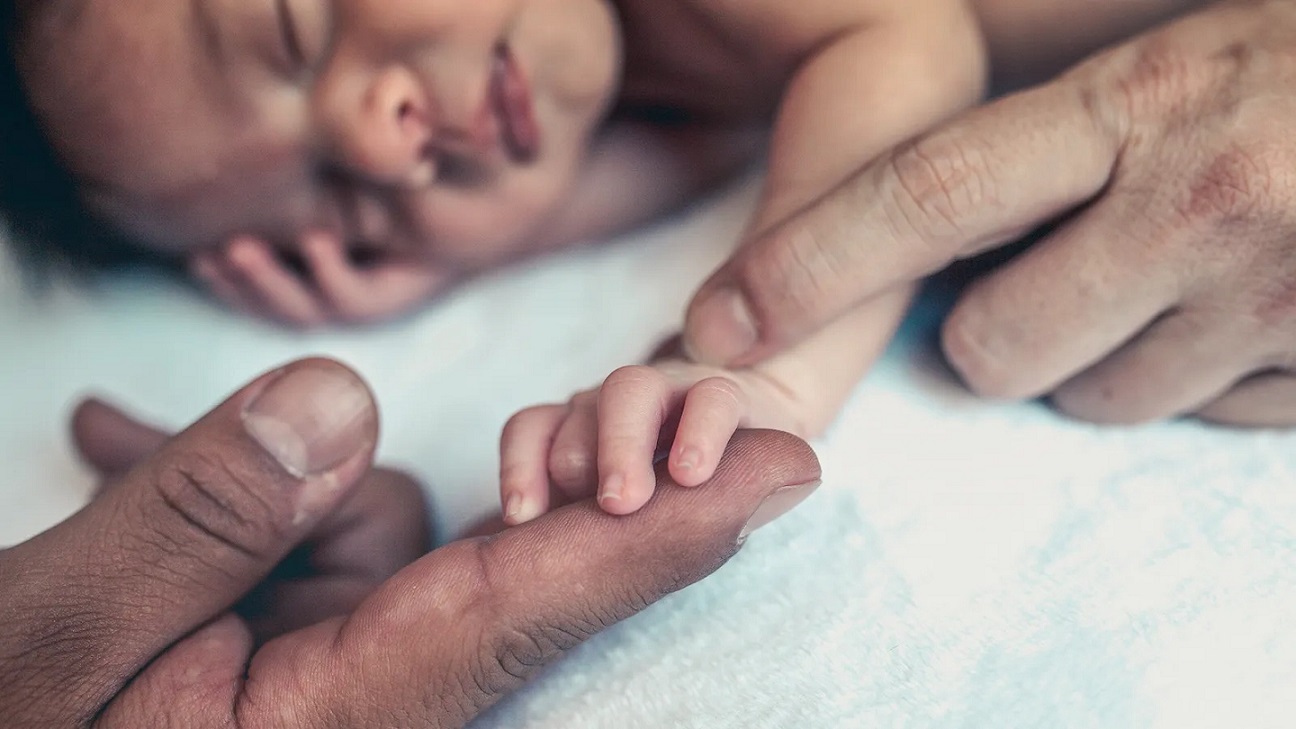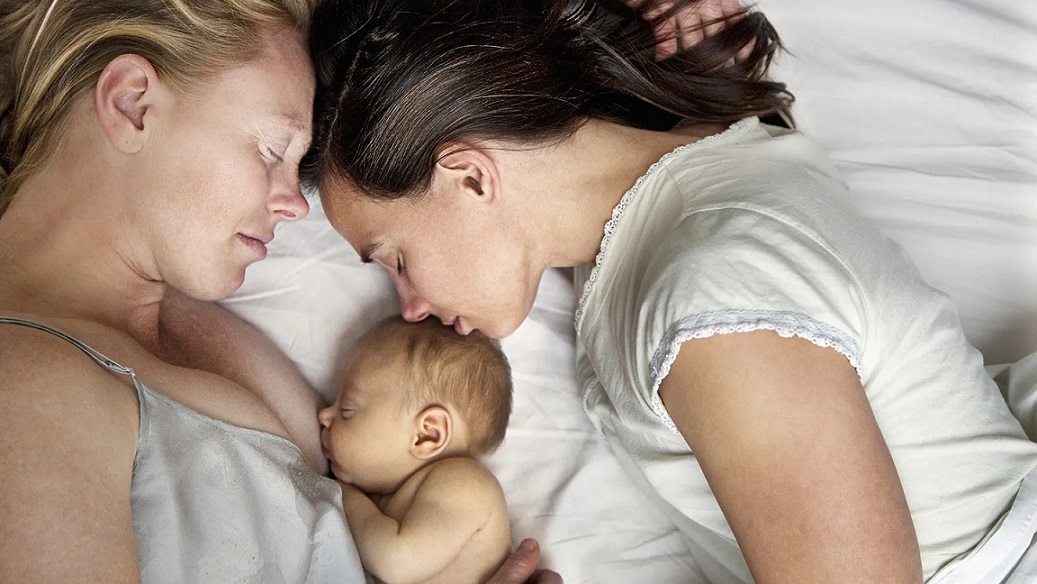 “三人”婴儿有权知道自己的捐献者吗?
“三人”婴儿有权知道自己的捐献者吗?
Should ''three-person babies'' have the right to know their donors?
译文简介
越来越多的孩子是在一项开创性技术的帮助下出生的,这实际上意味着他们携带着三个人的遗传物质,掀起了一场关于他们应该享有什么权利的新辩论。
正文翻译

A growing number of children have been born with the help of a pioneering technique that effectively means they carry genetic material from three people. It is opening up a new debate on what rights they should have.
越来越多的孩子是在一项开创性技术的帮助下出生的,这实际上意味着他们携带着三个人的遗传物质,掀起了一场关于他们应该享有什么权利的新辩论。
A groundbreaking fertility procedure that uses DNA from three people to prevent devastating mitochondrial diseases has resulted in the birth of several healthy babies in a number of countries around the world – including, most recently, in the UK.
这种开创性的生殖手术利用三个人的 DNA来预防致命的线粒体疾病,世界上多个国家已经利用这种手术(包括最近在英国)诞生了多名健康的婴儿。
这种开创性的生殖手术利用三个人的 DNA来预防致命的线粒体疾病,世界上多个国家已经利用这种手术(包括最近在英国)诞生了多名健康的婴儿。
The new technique, called mitochondrial replacement therapy, gives hope to couples who have lost children to rare genetic conditions. But it has also faced opposition, partly because of broader concerns around processes that involve genetic modifications in humans.
这项新技术名为线粒体替代疗法,为那些因罕见遗传病而失去孩子的夫妇带来了希望。但也不乏反对声音,部分原因是人们普遍担忧该技术涉及人类基因改造。
这项新技术名为线粒体替代疗法,为那些因罕见遗传病而失去孩子的夫妇带来了希望。但也不乏反对声音,部分原因是人们普遍担忧该技术涉及人类基因改造。
With some of the first children to be born using mitochondrial donation turning seven years old this year, and the technique becoming more widely used, regulators and parents are also facing ethical questions to do with the children's identity and origin.
随着第一批利用线粒体捐献出生的部分孩子今年七岁了,以及该技术的应用变得越来越普遍,监管机构和父母也面临着涉及孩子的出身和血缘的伦理问题。
随着第一批利用线粒体捐献出生的部分孩子今年七岁了,以及该技术的应用变得越来越普遍,监管机构和父母也面临着涉及孩子的出身和血缘的伦理问题。
One crucial question being raised is whether the children should have the right to know their mitochondrial donors' identity.
人们提出一个关键问题是,孩子是否应该有权知道他们的线粒体捐献者的身份。
人们提出一个关键问题是,孩子是否应该有权知道他们的线粒体捐献者的身份。
Experts say that existing research on more established forms of donor-assisted conception, such as sperm and egg donation could help answer those questions – and find the best way to ensure the children's emotional wellbeing.
专家表示,目前针对捐精和捐卵等成熟的供体受孕的研究有助于解答这些问题——并找到如何确保儿童情感健康的最佳办法。
专家表示,目前针对捐精和捐卵等成熟的供体受孕的研究有助于解答这些问题——并找到如何确保儿童情感健康的最佳办法。
Mitochondria are found inside most human cells where they act as mini power plants turning sugar into energy and they also carry their own DNA
线粒体存在于大多数人体细胞内,充当着将糖分转化为能量的微型发电厂,线粒体还携带自己的 DNA
线粒体存在于大多数人体细胞内,充当着将糖分转化为能量的微型发电厂,线粒体还携带自己的 DNA
Mitochondria are special compartments inside our cells that convert the energy found in food into a form that can be used to power bodies. But they can't do this if they carry faults that lead to disease. We inherit our mitochondria from our mothers, so a woman who carries some faulty mitochondria can pass these onto her children.
线粒体是我们细胞内的特殊隔间,能够将食物能量转化成为人体供能的形式。但如果线粒体存在致病缺陷,它们就失去了这个功能。我们的线粒体来自母系遗传,因此女性会将有缺陷的线粒体遗传给她的后代。
线粒体是我们细胞内的特殊隔间,能够将食物能量转化成为人体供能的形式。但如果线粒体存在致病缺陷,它们就失去了这个功能。我们的线粒体来自母系遗传,因此女性会将有缺陷的线粒体遗传给她的后代。
Mitochondrial replacement therapy is a form of IVF that combines the DNA from a mother and father inside an egg donated by another woman that contains healthy mitochondria.
线粒体替代疗法是一种体外受精方式,将父母双方的 DNA 结合后,植入另一名女性捐献的卵子中,该卵子含有健康的线粒体。
线粒体替代疗法是一种体外受精方式,将父母双方的 DNA 结合后,植入另一名女性捐献的卵子中,该卵子含有健康的线粒体。
The resulting embryo carries DNA from the two parents, but also carries a tiny amount of genetic material from the donor – around 0.1%. This donor DNA is contained within the mitochondria itself. Experts emphasise that the baby should not be regarded as a "three-parent" baby, but a "three-person" baby: they have two parents, and a donor.
由此诞生的胚胎携带父母双方的 DNA,但也携带少量来自捐献者的遗传物质——大约 0.1%,捐献者的 DNA 包含在线粒体中。专家强调,这种婴儿不应被视为“三亲”婴儿,而是“三人”婴儿:他们有两个父母,一个捐献者。
原创翻译:龙腾网 http://www.ltaaa.cn 转载请注明出处
由此诞生的胚胎携带父母双方的 DNA,但也携带少量来自捐献者的遗传物质——大约 0.1%,捐献者的 DNA 包含在线粒体中。专家强调,这种婴儿不应被视为“三亲”婴儿,而是“三人”婴儿:他们有两个父母,一个捐献者。
原创翻译:龙腾网 http://www.ltaaa.cn 转载请注明出处
Around the world, rules around the procedure are still evolving. The UK has pioneered laws and regulations to allow mitochondrial replacement techniques, and remains one of the few countries to have explicitly legalised it. Australia also legalised the procedure in 2022.
全世界针对这种手术的法规仍在完善当中。英国率先制定了允许使用线粒体替代技术的法律法规,至今仍是少数几个明确将其合法化的国家之一。2022年,澳大利亚也将这种手术合法化了。
全世界针对这种手术的法规仍在完善当中。英国率先制定了允许使用线粒体替代技术的法律法规,至今仍是少数几个明确将其合法化的国家之一。2022年,澳大利亚也将这种手术合法化了。
In the United States, the procedure is de facto banned: clinical research using mitochondrial replacement techniques in humans cannot legally proceed after the Food and Drug Administration expressed safety concerns. In Canada, the procedure is also banned. However, people have found ways to circumvent such restrictions by involving countries with laxer or absent rules. In 2016 a boy was born to a Jordanian couple in the US with the help of a mitochondrial replacement procedure, part of which was carried out in Mexico.
美国实际上禁止了这种手术:在美国食品和药物管理局表示安全担忧后,利用线粒体替代技术进行人体临床研究是违法的。加拿大也禁止了这种手术。然而人们想出了规避法规限制的办法,让那些法规比较宽松或缺失的国家参与其中。2016 年,一对约旦夫妇在线粒体替代手术的帮助下在美国生下一名男婴,其中一部分手术是在墨西哥进行的。
美国实际上禁止了这种手术:在美国食品和药物管理局表示安全担忧后,利用线粒体替代技术进行人体临床研究是违法的。加拿大也禁止了这种手术。然而人们想出了规避法规限制的办法,让那些法规比较宽松或缺失的国家参与其中。2016 年,一对约旦夫妇在线粒体替代手术的帮助下在美国生下一名男婴,其中一部分手术是在墨西哥进行的。
Unlike the parents' DNA, the donor's mitochondrial DNA does not influence traits such as hair or eye colour, or personality. This difference, and the fact that only a tiny bit of genetic material is from the mitochondrial donor, has had important regulatory consequences.
与父母的 DNA 不同,捐献者的线粒体 DNA 不会影响头发、眼睛颜色、性格等特征。这种差异,以及只有一丁点遗传物质来自线粒体捐献者的事实,已经造成了重大的监管后果。
与父母的 DNA 不同,捐献者的线粒体 DNA 不会影响头发、眼睛颜色、性格等特征。这种差异,以及只有一丁点遗传物质来自线粒体捐献者的事实,已经造成了重大的监管后果。
In the UK, a woman who donates her eggs for use in mitochondrial donation treatment is not considered the genetic parent of the resulting child, and remains anonymous – and the resulting child cannot apply to find out her identity. From the age of 16, a child can, however, access some non-identifying information about their mitochondrial donor, such as information about their personal and family medical history.
在英国,捐献卵子用于线粒体捐献治疗的女性不被视为孩子的亲生父母,并且保持匿名——所生的孩子不能申请查明该女性的身份。但是从 16 岁起,孩子可以了解线粒体捐献者的某些非身份信息,例如个人和家族的病史。
原创翻译:龙腾网 http://www.ltaaa.cn 转载请注明出处
在英国,捐献卵子用于线粒体捐献治疗的女性不被视为孩子的亲生父母,并且保持匿名——所生的孩子不能申请查明该女性的身份。但是从 16 岁起,孩子可以了解线粒体捐献者的某些非身份信息,例如个人和家族的病史。
原创翻译:龙腾网 http://www.ltaaa.cn 转载请注明出处
Sperm and egg donation, in contrast, is now open-identity only in the UK (the child can apply to know the donor's identity when they are 18).
相比之下,目前只有英国允许精子和卵子捐献者公开身份(孩子年满18岁可以申请了解捐献者的身份)。
相比之下,目前只有英国允许精子和卵子捐献者公开身份(孩子年满18岁可以申请了解捐献者的身份)。
John Appleby, a lecturer in medical ethics at Lancaster University, in the UK, disagrees with the UK's regulatory decision to make mitochondrial donation legally anonymous. He argues that children conceived via mitochondrial donation should have the right to find out the donor's identity, as they do in the UK in the case of sperm and egg donation.
约翰·阿普尔比是英国兰开斯特大学的医学伦理学讲师,他不同意英国监管机构让线粒体捐献者保持法定匿名的决定。他认为,通过线粒体捐献孕育出来的孩子应该有权查明捐献者的身份,正如英国的精子和卵子受捐者享有这样的权利。
约翰·阿普尔比是英国兰开斯特大学的医学伦理学讲师,他不同意英国监管机构让线粒体捐献者保持法定匿名的决定。他认为,通过线粒体捐献孕育出来的孩子应该有权查明捐献者的身份,正如英国的精子和卵子受捐者享有这样的权利。
"The psychological evidence to date indicates that some people conceived with donated eggs, sperm or embryos, feel it is important to know identifying information about their donors," he says. "They tend to express a number of reasons why, ranging from wanting to thank the donor, wanting to find other siblings, or because it matters that they have any genetic tie to their donor and possibly want to meet them."
“迄今为止的心理学证据表明,一些利用捐献的卵子、精子、胚胎孕育出来的人觉得,了解捐献者的身份信息很重要”,他说道。“他们往往罗列出许多理由,包括希望感谢捐献者,希望找到其他兄弟姐妹,或者因为重要的是,与他们有血缘关系的捐献者可能希望见到他们”。
“迄今为止的心理学证据表明,一些利用捐献的卵子、精子、胚胎孕育出来的人觉得,了解捐献者的身份信息很重要”,他说道。“他们往往罗列出许多理由,包括希望感谢捐献者,希望找到其他兄弟姐妹,或者因为重要的是,与他们有血缘关系的捐献者可能希望见到他们”。
In his view, many of those interests would also potentially apply to mitochondrial donation, which, after all, uses part of the eggs from a donor. In particular, there may be reasons that are not just about the genetic connection, and the quantity of genes passed on. "Based on what we know about people's motivations for wanting to contact their donor, the fact that a mitochondrial donor gave someone a life free of a terrible disease is likely a good reason for the donor-conceived person to want to contact them."
在他看来,其中的许多好奇心可能也适用于线粒体捐献,因为毕竟使用了捐献者的部分卵子。可能有些理由不只涉及到血缘关系和遗传的基因数量。“根据我们了解的人们想要联系捐献者的动机,线粒体捐献者使对方免于患上可怕的疾病,这一事实可能是受捐者想要联系他们的主要原因”。
原创翻译:龙腾网 http://www.ltaaa.cn 转载请注明出处
在他看来,其中的许多好奇心可能也适用于线粒体捐献,因为毕竟使用了捐献者的部分卵子。可能有些理由不只涉及到血缘关系和遗传的基因数量。“根据我们了解的人们想要联系捐献者的动机,线粒体捐献者使对方免于患上可怕的疾病,这一事实可能是受捐者想要联系他们的主要原因”。
原创翻译:龙腾网 http://www.ltaaa.cn 转载请注明出处
Decades of research on new forms of families suggests that children are far more flexible about issues like their biological origins and genetic-relatedness than was previously thought. Open communication with the child about their origins, and being donor-conceived, has also been shown to be very important for their wellbeing.
数十年来对新型家庭的研究表明,儿童在血缘和遗传相关性等问题上比以前想象的要灵活得多。与孩子就他们的血缘和供体受孕进行坦诚的交流也证明对他们的健康非常重要。
数十年来对新型家庭的研究表明,儿童在血缘和遗传相关性等问题上比以前想象的要灵活得多。与孩子就他们的血缘和供体受孕进行坦诚的交流也证明对他们的健康非常重要。
A longitudinal study by the University of Cambridge Centre for Family Research followed up children born through egg donation from infancy to adulthood. It investigated a range of questions about their wellbeing, identity and relationships, such as how they felt when they learned about their biological origins and the quality of their relationship with their mothers (who used donated eggs to have them). Findings from the most recent phase of the study, published in 2023 and based on research done when the young people reached the age of 20 showed that they had good relationships with their parents and high levels of psychological wellbeing.
剑桥大学家庭研究中心进行了一项纵向研究,追踪了通过捐卵出生的儿童从婴儿期到成年期的情况。针对他们的幸福感、身份认同、人际关系做了一系列调查,例如当他们得知自己血缘时的感受、与母亲的关系质量(利用捐献的卵子孕育他们)。根据2023年公布的最新研究阶段的结论,并结合对这些年轻人达到20岁时所做的调查,表明他们与父母的关系良好,心理健康水平较高。
剑桥大学家庭研究中心进行了一项纵向研究,追踪了通过捐卵出生的儿童从婴儿期到成年期的情况。针对他们的幸福感、身份认同、人际关系做了一系列调查,例如当他们得知自己血缘时的感受、与母亲的关系质量(利用捐献的卵子孕育他们)。根据2023年公布的最新研究阶段的结论,并结合对这些年轻人达到20岁时所做的调查,表明他们与父母的关系良好,心理健康水平较高。
Susan Golombok, professor emerita of family research and former director of the Centre for Family Research at the University of Cambridge, who led the study, says she would expect similar findings among children born after mitochondrial donation.
剑桥大学的家庭研究名誉教授、家庭研究中心前主任苏珊·戈隆贝克主持了这项研究,她表示期待从那些通过线粒体捐献而出生的孩子中得出类似的结论。
剑桥大学的家庭研究名誉教授、家庭研究中心前主任苏珊·戈隆贝克主持了这项研究,她表示期待从那些通过线粒体捐献而出生的孩子中得出类似的结论。
"As 50% of the children's genes were from an egg donor, whereas only mitochondrial DNA comes from the egg donor in children born through mitochondrial donation, it is not expected that the children would experience psychological difficulties as a result of their method of conception," she says.
“儿童基因有50%来自卵子捐献者,而通过线粒体捐献出生的儿童只有线粒体DNA来自卵子捐献者,他们应该不会因为受孕方式而产生心理障碍”,她说道。
“儿童基因有50%来自卵子捐献者,而通过线粒体捐献出生的儿童只有线粒体DNA来自卵子捐献者,他们应该不会因为受孕方式而产生心理障碍”,她说道。

Families where mothers conceived using sperm donation offer insights into how children born from mitochondrial replacement might feel about their donors
从一个母亲通过捐精受孕的家庭可以看出,通过线粒体替代而出生的孩子可能对捐献者有何感受。
An important finding from the study is that children born through egg donation benefit from being told about their donor conception when they are young, says Golombok. "Although the psychological implications of mitochondrial donation [might] appear to be less significant, it seems likely that these children also would benefit from openness about their conception," she adds.
这项研究得出一个重要结论,如果孩子从小就知道自己捐卵受孕的身世,这对他们来说是有益的,戈隆贝克说道。“尽管线粒体捐献造成的心理影响可能不大,但坦言相告好像也能让这些儿童受益,”她补充道。
这项研究得出一个重要结论,如果孩子从小就知道自己捐卵受孕的身世,这对他们来说是有益的,戈隆贝克说道。“尽管线粒体捐献造成的心理影响可能不大,但坦言相告好像也能让这些儿童受益,”她补充道。
Research on families created with the help of sperm donation sheds further light on the benefits of openness, and may help when it comes to envisaging how a three-person IVF baby may one day feel about their donor.
针对在捐献精子的帮助下建立家庭的研究进一步揭示了坦言相告的好处,可能有助于展望三亲试管婴儿有一天会对捐献者有何感受。
针对在捐献精子的帮助下建立家庭的研究进一步揭示了坦言相告的好处,可能有助于展望三亲试管婴儿有一天会对捐献者有何感受。
"I think it's terrific that parents who would ordinarily lose a child to mitochondrial disease now have a potential option for giving birth to a healthy child," says Nanette Gartrell, a psychiatrist and principal investigator at the National Longitudinal Lesbian Family Study in the US. The study, which began in the 1980s, has followed a group of lesbian mothers who conceived children via sperm donation, and also followed the children's development and wellbeing into adulthood. Gartrell says the study's findings hold important wider lessons, for example when it comes to the issue of openness versus secrecy around donor conception.
“父母原本会因为线粒体疾病而失去孩子,现在可以选择生下健康的孩子,我认为这太棒了”,来自美国“国家纵向女同性恋家庭研究”的精神病学家兼首席研究员纳内特·加特雷尔说道。这项研究始于 20世纪80 年代,追踪了一批捐精受孕的女同性恋母亲,并追踪了孩子成年后的发育和健康状况。加特雷尔表示,研究成果积累了重要而广泛的经验,例如在供体受孕方面应该坦言相告还是保密的问题。
“父母原本会因为线粒体疾病而失去孩子,现在可以选择生下健康的孩子,我认为这太棒了”,来自美国“国家纵向女同性恋家庭研究”的精神病学家兼首席研究员纳内特·加特雷尔说道。这项研究始于 20世纪80 年代,追踪了一批捐精受孕的女同性恋母亲,并追踪了孩子成年后的发育和健康状况。加特雷尔表示,研究成果积累了重要而广泛的经验,例如在供体受孕方面应该坦言相告还是保密的问题。
"Children conceived by sexual minority parents through assisted reproductive technology know about their conception from early childhood," says Gartrell. The mothers in the study, for example, were always open with their children about their origins. As adults, roughly half of the donor-conceived children in the study reported good relationships with their donors, while 20% wished for more contact.
“性少数父母通过辅助生殖技术生下的孩子从小就知道自己的身世”,加特雷尔说道。例如,这项研究中的母亲都对孩子的身世坦言相告。研究中约有一半供体受孕的儿童在成年后表示与捐献者的关系良好,20% 的人希望与捐献者有更多的联系。
原创翻译:龙腾网 http://www.ltaaa.cn 转载请注明出处
“性少数父母通过辅助生殖技术生下的孩子从小就知道自己的身世”,加特雷尔说道。例如,这项研究中的母亲都对孩子的身世坦言相告。研究中约有一半供体受孕的儿童在成年后表示与捐献者的关系良好,20% 的人希望与捐献者有更多的联系。
原创翻译:龙腾网 http://www.ltaaa.cn 转载请注明出处
Interestingly, those who had a positive relationship tended to highlight factors other than their genetic connection, such as the donor's kind personality, or the fact that they talked to each other a lot. Some participants said that looking for a resemblance was part of why they had wanted to meet their donor, while others reported a more general curiosity. One participant wrote that before meeting his donor, he felt "the mystique of unknown origins".
有趣的是,与捐献者有良好关系的人往往看重血缘关系以外的因素,例如捐献者的友好性格,或者彼此相谈甚欢。有些参与者表示寻找相似之处是他们想见到捐献者的部分原因,也有参与者说是出于一般的好奇心。一位参与者写道,在见到捐献者之前,他有一种“身世不明的神秘感”。
有趣的是,与捐献者有良好关系的人往往看重血缘关系以外的因素,例如捐献者的友好性格,或者彼此相谈甚欢。有些参与者表示寻找相似之处是他们想见到捐献者的部分原因,也有参与者说是出于一般的好奇心。一位参与者写道,在见到捐献者之前,他有一种“身世不明的神秘感”。
Based on her research and wider knowledge of the impact of secrecy versus openness on children conceived via sperm donation, Gartrell argues that openness and the opportunity to contact the donor at an age-appropriate time are more beneficial for the children than concealing it. "Human beings have a right to know their genetic origins to the extent possible," she says.
加特雷尔结合自己的研究,以及更广泛地认识到保密与坦诚对捐精诞生的儿童的影响,她认为相比隐瞒真相,坦言相告和在适当的年龄有机会联系捐献者对孩子更有好处。她说:“人类有尽可能了解自己身世的权利”。
加特雷尔结合自己的研究,以及更广泛地认识到保密与坦诚对捐精诞生的儿童的影响,她认为相比隐瞒真相,坦言相告和在适当的年龄有机会联系捐献者对孩子更有好处。她说:“人类有尽可能了解自己身世的权利”。
In the case of mitochondrial donation, there may also be other reasons why the child may wish to know, according to Gartrell. "Informing children of the mitochondrial donation that prevented a fatal disease is also important because this information may prove medically helpful to those children in ways that scientists are currently unaware. As a psychiatrist and researcher, I would consider this disclosure similar to informing a child that a life-saving foetal cardiac procedure was performed on them, for example."
据加特雷尔所说,接受线粒体捐赠的孩子希望了解自己的身世可能还有其他理由。“告诉孩子接受过预防致命疾病的线粒体捐赠也很重要,因为这些信息可能对这些孩子有医学帮助,只不过现在的科学家还做不到。作为一名精神病学家和研究人员,我认为这种坦诚相告相当于告诉孩子,他们接受过救命的胎儿心脏手术”。
据加特雷尔所说,接受线粒体捐赠的孩子希望了解自己的身世可能还有其他理由。“告诉孩子接受过预防致命疾病的线粒体捐赠也很重要,因为这些信息可能对这些孩子有医学帮助,只不过现在的科学家还做不到。作为一名精神病学家和研究人员,我认为这种坦诚相告相当于告诉孩子,他们接受过救命的胎儿心脏手术”。
For now, the pioneering procedure of mitochondrial donation treatment may feel like we're treading completely new ground – creating an entirely new kind of human, in a way. But as these studies on other reproductive technologies suggest, the children themselves may be far less fazed by their origins than the public. Whether and how soon the public will embrace the technique may, however, continue to vary from country to country – just as societies still show varying attitudes to standard IVF.
目前,开创性的线粒体捐献治疗手术可能让人觉得我们正在涉足全新的领域——在某种程度上创造了一种全新的人类。但正如其他生殖技术方面的研究所表明的,孩子自己可能远没有公众那么担心自己的出身。但是,公众是否以及多久以后接受这项技术可能因国家而异——正如社会仍然对普通的体外受精方式态度不一。
目前,开创性的线粒体捐献治疗手术可能让人觉得我们正在涉足全新的领域——在某种程度上创造了一种全新的人类。但正如其他生殖技术方面的研究所表明的,孩子自己可能远没有公众那么担心自己的出身。但是,公众是否以及多久以后接受这项技术可能因国家而异——正如社会仍然对普通的体外受精方式态度不一。
评论翻译
很赞 ( 0 )
收藏